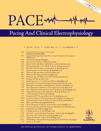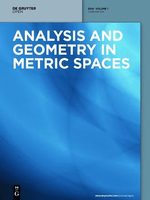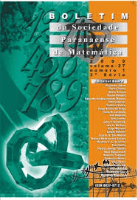
Tamkang Journal of Mathematics
Scope & Guideline
Connecting Researchers to the Heart of Mathematical Discovery
Introduction
Aims and Scopes
- Mathematical Analysis and Differential Equations:
The journal frequently publishes research on various aspects of mathematical analysis, particularly focusing on differential equations, including ordinary, partial, and fractional differential equations. - Topological and Geometric Studies:
There is a significant emphasis on topology and geometry, with many papers exploring concepts such as manifolds, curvature, and geometric invariants. - Fixed Point Theory and Variational Methods:
The exploration of fixed point theorems, particularly in relation to variational inequalities and nonexpansive mappings, is a consistent theme, highlighting the journal's commitment to foundational mathematical constructs. - Mathematical Modeling and Applications:
The journal includes studies on mathematical modeling in various contexts, such as epidemiological models and dynamic systems, demonstrating the relevance of mathematics in real-world applications. - Statistical and Probabilistic Methods:
Research on statistical methods, including entropy measures and probabilistic metric spaces, is also a focus area, indicating the journal's breadth in mathematical fields.
Trending and Emerging
- Nonlinear Dynamics and Control:
There is a growing interest in nonlinear systems, particularly in the context of control theory and dynamical systems, as evidenced by an increase in papers focusing on optimal control and stability analysis. - Fractional Calculus and Differential Equations:
The study of fractional differential equations has gained traction, reflecting an emerging trend towards exploring non-integer order derivatives and their applications in various scientific fields. - Mathematical Biology and Epidemiology:
The journal has seen a rise in publications related to mathematical modeling of biological systems, particularly in epidemiology, showcasing the relevance of mathematics in addressing public health issues. - Advanced Numerical Methods:
There is an increasing focus on numerical analysis and computational methods for solving complex mathematical problems, indicating a trend towards applied mathematics and computational techniques. - Geometric Analysis and Differential Geometry:
Research in geometric analysis, particularly involving curvature and geometric properties of manifolds, is on the rise, highlighting the ongoing interest in the interplay between geometry and analysis.
Declining or Waning
- Classical Algebraic Structures:
There is a diminishing emphasis on classical topics such as ring theory and algebraic structures, which were more prominent in earlier publications. - Elementary Number Theory:
Research focusing on elementary number theory and its applications has decreased, suggesting a shift towards more complex and applied mathematical concepts. - Basic Graph Theory:
While graph theory remains a relevant topic, the journal has published fewer papers on foundational aspects, indicating a movement towards more specialized or advanced applications of graph theory. - Discrete Mathematics:
The prominence of discrete mathematics in the journal's offerings has waned, possibly reflecting a broader trend in mathematics towards continuous and analytical methods.
Similar Journals

Sahand Communications in Mathematical Analysis
Connecting scholars through groundbreaking mathematical discourse.Sahand Communications in Mathematical Analysis is a distinguished open-access journal published by the University of Maragheh in Iran, dedicated to the field of mathematical analysis and its applied branches. Since its inception in 2014, the journal has provided a valuable platform for researchers to disseminate significant findings in areas ranging from analytical methods to numerical analysis and applied mathematics. Despite its relatively recent establishment, the journal has quickly gained recognition, noted for its Q3 rankings in both Applied Mathematics and Numerical Analysis categories, and its Q4 ranking in Analysis for 2023. With an ambition to foster innovative research and facilitate scholarly dialogue, Sahand Communications in Mathematical Analysis aims to support the global mathematical community by ensuring unrestricted access to high-quality research outputs. Researchers, professionals, and students can look forward to engaging content that pushes the boundaries of mathematical inquiry through its open-access model, thus enhancing the accessibility and reach of critical mathematical discussions.

Revista Matematica Complutense
Cultivating Excellence in Mathematical ScholarshipRevista Matematica Complutense is a prestigious peer-reviewed journal published by SPRINGER-VERLAG ITALIA SRL, specializing in the field of mathematics. With its ISSN 1139-1138 and E-ISSN 1988-2807, the journal plays a vital role in disseminating high-quality research and fostering academic discussion within the mathematics community. Recognized for its rigorous selection process, the journal has achieved impressive rankings, holding a Q1 quartile status in the miscellaneous mathematics category as of 2023 and ranking #94 out of 399 in general mathematics according to Scopus, placing it within the 76th percentile. With a publication timeline spanning from 2008 to 2024, the Revista Matematica Complutense continues to serve as an essential resource for researchers, professionals, and students alike. Although it does not currently offer open access, the journal remains committed to advancing mathematical knowledge and providing a platform for innovative research across various mathematical disciplines.

Archivum Mathematicum
Advancing Mathematics: Theory, Applications, and EducationArchivum Mathematicum is an open-access journal dedicated to the broad spectrum of Mathematics, published by Masaryk University, Faculty of Science in the Czech Republic. Since its inception in 1965, this journal has provided a platform for the dissemination of research and advancements within the mathematical sciences. It spans converged years from 2004 to 2024, ensuring ongoing relevance in a rapidly evolving discipline. Currently categorized in Q4 for 'Mathematics (miscellaneous)' and ranked #316/399 in general mathematics by Scopus, the journal aims to foster a collaborative environment for researchers, practitioners, and students alike, encouraging submissions that contribute to mathematical theory, applications, and education. With its commitment to open access, Archivum Mathematicum is a vital resource for anyone seeking to stay informed about emerging trends and findings in the field.

Thai Journal of Mathematics
Championing innovative applications and insights in mathematical sciences.Thai Journal of Mathematics (ISSN: 1686-0209) is a distinguished publication within the mathematical sciences, based at Chiang Mai University, Faculty of Science in Thailand. With a focus on diverse mathematical topics, the journal has been actively publishing since 2011 and aims to present original research, reviews, and innovative applications that contribute to the global mathematical community. Despite its current Q4 ranking in Mathematics (miscellaneous) and a modest percentile in Scopus Ranks, it serves as a vital platform for researchers and educators looking to disseminate their findings and engage with emerging trends in mathematics. The journal supports open sharing of knowledge, fostering collaborations and discussions across borders, which is essential for the advancement of mathematical education and research. Researchers, professionals, and students are encouraged to contribute and access valuable insights that shape the future of mathematics.

ANNALI DI MATEMATICA PURA ED APPLICATA
Elevating Mathematical Discourse Since 1858ANNALI DI MATEMATICA PURA ED APPLICATA is a prestigious journal published by Springer Heidelberg, focusing on the field of Applied Mathematics. With a rich history dating back to its initial publication stages from 1858, this journal continues to serve as a vital platform for researchers and professionals seeking to disseminate high-quality, peer-reviewed research. The journal's strong reputation is reflected in its Q1 ranking in Applied Mathematics and its Scopus rank of #335 out of 635, placing it in the 47th percentile, showcasing its impact in the field. Although it is not an open-access journal, it provides exclusive insights and advancements in mathematical applications, allowing academics to explore innovative methodologies and theoretical developments. The combination of its long-standing tradition and contemporary relevance makes ANNALI DI MATEMATICA PURA ED APPLICATA an essential resource for scholars and students looking to deepen their understanding of mathematics and its practical applications.

PACE-PACING AND CLINICAL ELECTROPHYSIOLOGY
Elevating knowledge in the evolving field of electrophysiology.PACE - Pacing and Clinical Electrophysiology is a leading journal in the field of cardiology and cardiovascular medicine, published by Wiley. Since its inception in 1978, the journal has been instrumental in disseminating vital research, clinical studies, and advancements in the area of cardiac pacing and electrophysiology, extending its reach to diverse professionals and scholars. With an ISSN of 0147-8389 and an E-ISSN of 1540-8159, the journal is indexed in prominent databases, boasting a respectable impact factor that reflects its significance in the scientific community. As of 2023, PACE is ranked in the Q2 quartile for both Cardiology and Cardiovascular Medicine as well as Miscellaneous Medicine categories, placing it among the top resources for cutting-edge research and reviews. Although it is currently not an Open Access publication, PACE remains committed to advancing knowledge and practice in the field, providing vital insights into the latest technologies and methodologies in cardiac care. Whether you're a seasoned researcher, healthcare professional, or an enthusiastic student, PACE offers invaluable content that supports the continual development and innovation within the realm of electrophysiological studies.

COMMUNICATIONS IN ANALYSIS AND GEOMETRY
Unveiling New Dimensions in Analysis and GeometryCOMMUNICATIONS IN ANALYSIS AND GEOMETRY, published by INT PRESS BOSTON, INC, is a prestigious journal dedicated to advancing the fields of analysis, geometry, and statistics. With an impressive Q1 ranking in these categories for 2023, the journal stands out as a leading platform for cutting-edge research and scholarly discourse. Established in 1996, the journal has been instrumental in fostering a vibrant academic community that engages with both theoretical and applied aspects of mathematics. Despite not being an open-access journal, it continues to attract a wide readership owing to its rigorous peer-review process and high-impact publications. The journal's influence is further underlined by its respectable Scopus rankings, specifically in Geometry and Topology, where it ranks 40th out of 106, highlighting its significance in the scholarly landscape. Researchers, professionals, and students alike will find COMMUNICATIONS IN ANALYSIS AND GEOMETRY to be an invaluable resource for the latest findings and developments in these interconnected mathematical disciplines.

Analysis and Geometry in Metric Spaces
Fostering breakthroughs in analysis and geometry.Analysis and Geometry in Metric Spaces is a distinguished open-access journal published by DE GRUYTER POLAND SP Z O O, dedicated to advancing the fields of analysis, geometry, and applied mathematics. Since its inception in 2013, the journal has established itself as a vital resource for researchers and practitioners, consistently achieving high rankings in its categories, including Q1 in Analysis and Q2 in Applied Mathematics and Geometry and Topology, with notable Scopus rankings reflecting its impact within the mathematical community. The journal aims to foster scholarly exchange by publishing rigorous research articles that explore innovative trends and significant developments in metric space theory. With continuous open-access accessibility, it ensures that the latest findings are readily available to academics across the globe, thus contributing to the broader discourse within mathematics. As the journal prepares to bridge the years to 2024, it remains committed to serving as a cornerstone for advancements in its scope and a beacon for methodological breakthroughs.

Boletim Sociedade Paranaense de Matematica
Bridging Theories and Applications in MathematicsBoletim Sociedade Paranaense de Matematica is a distinguished journal within the field of Mathematics, published by the Sociedade Paranaense de Matemática in Brazil. With an ISSN of 0037-8712 and an E-ISSN of 2175-1188, this journal has been committed to fostering open access to mathematical research since 2002, ensuring that cutting-edge research is readily available to the academic community. Operating within the diverse landscape of mathematical studies and ranked Q3 for 2023 in the category of Mathematics (Miscellaneous), the journal serves as a platform for innovative contributions and discussions. It ranks 192nd out of 399 in the Scopus database for General Mathematics, reflecting its steady involvement in the global academic dialogue. The Boletim resides at JD AMERICAS, CAIXA POSTAL 19081, CURITIBA PR 81531-990, Brazil, and aims to connect researchers, practitioners, and students by promoting high-quality research and dissemination of mathematical knowledge. By bridging diverse mathematical theories and applications, the journal not only enhances understanding of the discipline but also drives future research directions.

COMMUNICATIONS ON PURE AND APPLIED ANALYSIS
Unveiling Insights in Pure and Applied AnalysisCOMMUNICATIONS ON PURE AND APPLIED ANALYSIS, published by the American Institute of Mathematical Sciences (AIMS), is a pivotal journal that serves the fields of pure and applied mathematics. With an ISSN of 1534-0392 and an E-ISSN of 1553-5258, this journal showcases rigorous research findings that span a myriad of topics within mathematical analysis and its applications. Given its impressive Q2 ranking in both Analysis and Applied Mathematics categories, it is recognized for its significant contributions, ranking 92nd out of 193 in Analysis and 369th out of 635 in Applied Mathematics according to Scopus. The journal, running continuously from 2004 to 2024, invites submissions that push the boundaries of mathematical thought and practice. While it operates under a traditional access model, the journal's comprehensive scope and burgeoning impact factor underscore its importance for researchers, professionals, and students who seek to engage deeply with current mathematical advancements.